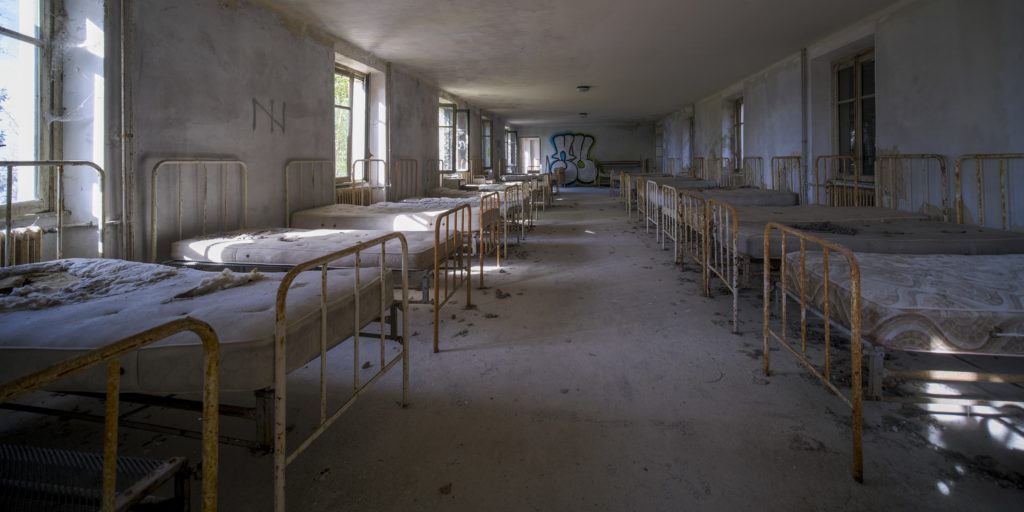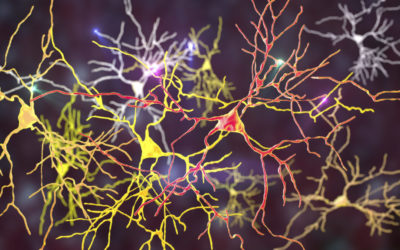An Astounding and Underated Story of Brain Development
Reading time: about 7 minutes

The story goes that Harold M. Skeels, on taking over responsibility for the Iowa state psychiatric institutions in 1938, walked into the Iowa State orphanage which was situated within a complex including wards for the mentally retarded and sick, and saw two little girls sitting on the floor whining and crying and rocking back and forth.
He described them as such:
“The youngsters were pitiful little creatures. They were tearful, had runny noses, and coarse, stringy, and colorless hair; they were emaciated, undersized, and lacked muscle tone or responsiveness. Sad and inactive, the two spent their days rocking and whining”
This was back in 1938 and these institutions are what would be unthinkable today. This was one large ward with dozens children in it and only two nurses to look after them. One of the key roles of the orphanage was also to find or match children to potential adoptive parents. However, under state law those considered retarded couldn’t be put up for adoption. These two girls, as you can see from the outline above were considered retarded with estimated IQs of between 35 and 46 (100 being the norm).
A Harsh Decision
With no beds free and children to be admitted, Skeels made what sounds like a harsh decision. Skeels was not a bad man, on the contrary, he was a very good man, but he did need space to look after more children. He therefore made the decision to have these two unresponsive retarded girls moved to a ward for women who were themselves considered retarded or mentally sick. A side note is that in this dark chapter of US history many things could lead to women being considered “feeble of mind”.
So, these two girls transferred, their needs would be taken care of. They had warmth, protection, shelter, and nutrition. He left to tour and attend to other businesses in other locations. He returned three months later.
On his return he went to the ward to check up on these two girls. What he found was astounding — and also went against all beliefs held at the time: what it took to bring up children, who could do this, and whether you were born with intelligence, or born an imbecile.
The Transformation
On entering the ward he was met with two unrecognisable little girls. The girls were little bundles of energy and activity. Full of life and responsive to those around them. A transformation so complete he at first did not believe these were the same girls. They were.
This went against everything everyone assumed at the time. You were born with a good mind or bad. You were retarded or you weren’t. If you were mentally ill, or retarded, there is not way possible that you could be a good mother. Yet, here he had evidence to the contrary — two little retarded girls had over period of only three months been transformed.
He measured their IQs and they came in at 77 and 87, no longer considered retarded. This was measured again a few months later and IQ scores for both girls were now mid 90s close to the norm.
How Could This Happen?
This was the question he asked himself, and then asked the nurses, and the women on the ward, but also observed them over the next few months.
What had happened is that these children were met with warmth, love, and heaps of attention. This was also the best thing to happen to the nurses on the ward and the women in the ward. What happened is one of the women become a main motherly figure and the other women become doting and loving aunts.
They stimulated them, played with them, comforted them, catered to their needs, made them toys, knitted them clothes. These girls had moved from a large ward with no attention to an environment full of love, attention, and stimulation. And it is this that led these girls within a short period of time to blossom.
It showed a number of important things. First, IQ, particularly in younger years, is not static but is as much as an environmental factor as genetic factor. Second, that to be a good parent you just needed love and the ability to care and give children the attention they need.
But was this really the case? To prove it Skeels set up an experiment that would be unthinkable today.
The Experiment
Based on this extraordinary experience, and full of excitement Skeels and a colleague, Dye, made a request to the authorities to run an experiment. In this they planned to place children in the mental health ward, and then follow their progress in contrast to another group kept in the orphanage.
They selected 13 one to two-year olds 11 of whom were classed as retarded (average IQ 67) and so unsuitable for adoption. These were now placed with teenage girls with mental retardation who lived at the institution. However, in contrast to the first girls, these young women were taught and guided in how to give basic care and attention to these young children. In addition the young children also attended a half morning kindergarten programme at the institution.
12 children were selected for the contrast group. These were kept at the orphanage as normal. Their IQs averaged 87 and only two were classed as mentally retarded.
What Happened?
After two years all the children were tested again — with astounding results.
Thos children who had been assigned to “mothers” showed an average improvement of IQ score of 27.5 points. This was enough for 11 of the 13 to become eligible for adoption. This was an amazing result in itself but even more so when contrasted to the “control” group — those who had stayed in the orphanage.
Those who had stayed in the orphanage showed an average decrease of 26 IQ points. They hence moved from hovering around below average IQ to mentally retarded.
This is in itself a fascinating and powerful piece of evidence. But it becomes even more powerful because 25 years later Skeels then managed to track down the majority of the children to gauge how well they had fared in life.
From Retardation to Contributing to Society
Form the 13 children in the experimental group 11 had married and this led to 9 children, all of normal intelligence it should be noted. The median educational level was 12th grade and four had attended college. The jobs ranged from homemaker to business and professional work with only those two who had not been adopted working in domestic services.
In contrast those 12 children who had remained in the orphanage for the study fared much less positively. The median level of education was only the third grade. Four were still institutionalised, and the others all worked in unskilled jobs (except one).
What has Changed?
Skeels noted in his follow up study that if his work could just stimulate some change or further research his work had been a success. He noted the obvious that there is potential in many children that cannot be unlocked because of the condition and environments they are in.
His work did indeed contribute to the changes in the orphanages and so was a resounding success. What is also forgotten is that because of prevailing opinions at the time his work was attacked viciously by many within and without the academic community. It takes a lot to change entrenched opinions.
There have been multiple other studies — of note are the orphanage studies which came about after the collapse of the Ceaușescu regime in Romania and children we found in dire conditions in dozens of orphanages. The result echoed those of Skeels study. Give the children good homes and their intelligence and behaviour rockets. However, this did depend on age and how long they had been institutionalised.
Remaining Persistent Opinions
I use the Skeels case in my talks on the brain and how this illustrates the plasticity of the brain — how the brain can and does change. But also how it clearly shows that human needs are critical to healthy development — our SCOAP model.
And though there is now also plenty of research into the brain science of what happens and how connections between brain cells can be destroyed with adversity in early childhood, it still feels like society doesn’t fully appreciate the value of enabling all young children to have access to education, stimulation, but also love and care.
We still seem to blame the mother or the person. The “they are born that way” mantra sits deep and strongly in human beings. No, the message is clear, they are that way because of their environment.
Skeels study also did not become as well-known as it deserved. On review there were multiple problems with the study, but that detracts from the overriding message. But societies and governments, in many countries, do now provide much better support for children, thankfully.
But it is still a useful reminder that investing in early childhood support for everybody in society is probably one of the best things you can do for society. it’s also a useful reminder of what human needs (SCOAP) can do for all of us●

Andy Habermacher
Andy is author of leading brains Review, Neuroleadership, and multiple other books. He has been intensively involved in writing and research into neuroleadership and is considered one of Europe’s leading experts. He is also a well-known public speaker speaking on the brain and human behaviour.
Andy is also a masters athlete (middle distance running) and competes regularly at international competitions (and holds a few national records in his age category).
References
Skeels Studies
Skeels, H M & Dye, H B (1939)
A study of the effects of differential stimulation on mentally retarded children
Proceedings and Addresses of the American Association on Mental Deficiency 44(1), 114–136.
Skeels, H. M. (1966)
Adult Status of Children with Contrasting Early Life Experiences: A Follow-Up Study.
Monogr. Soc. Res. Child Dev. 31.
doi:10.2307/1165791.
Articles
Long read on the Romanian orphans at the Atlantic
Long read on the Romanian orphans in the Guardian
Book
Brookwood, M. (2021)
The Orphans of Davenport: Eugenics, the Great Depression, and the War Over Children’s Intelligence.
New York: Liveright Publishing Corporation.
More Healthy Brains articles
The Little Known Brain Cells that Help You Stay Awake and Keep Your Brain Active
Different areas of the brain are associated with empathy – this new research shows how brain regions synchronise to induce empathic responses.
New Drivers of Selfishness and Collaboration Discovered
New studies shed more light on some contradictions and drivers of selfishness and collaboration Reading time: about 6 minutes how babies of only a few months old scenes of nice behaviour, such as helping another person, and bad behaviour,...
Brain Cells of Males and Females Respond Differently to Stress
Different areas of the brain are associated with empathy – this new research shows how brain regions synchronise to induce empathic responses.
Work in the Presence of Others Lowers Stress
Different areas of the brain are associated with empathy – this new research shows how brain regions synchronise to induce empathic responses.
Everyday Pleasures Improve Brain Performance
Different areas of the brain are associated with empathy – this new research shows how brain regions synchronise to induce empathic responses.
Smells Shown to Dramatically Boost Brain Power
Different areas of the brain are associated with empathy – this new research shows how brain regions synchronise to induce empathic responses.






